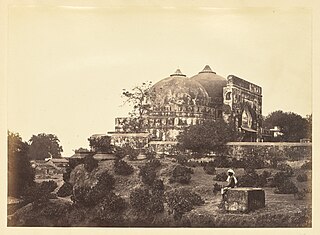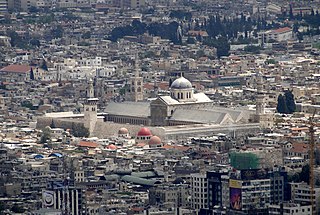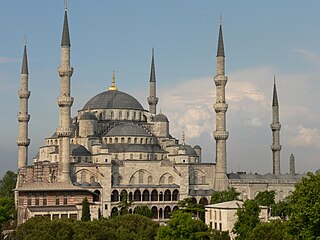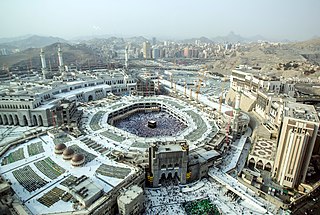A mosque or masjid is a place of prayer for Muslims. Mosques are usually covered buildings, but can be any place where prayers (salah) are performed, including outdoor courtyards.

The Temple Mount is a hill in the Old City of Jerusalem that has been venerated as a holy site in Judaism, Christianity, and Islam for thousands of years. It is the site of a large mosque compound known as Al-Aqsa or al-Aqsa mosque compound, known honorifically as al-Ḥaram al-Sharīf, and sometimes as Jerusalem's sacredesplanade.

Al-Aqsa Mosque, properly Jāmiʿ al-Aqṣā, also known as the Qibli Mosque or Qibli Chapel, is a congregational mosque or prayer hall in the Al-Aqsa mosque compound in the Old City of Jerusalem. In some sources the building is also named al-Masjid al-Aqṣā, but this name primarily applies to the whole compound in which the building sits, which is itself also known as "Al-Aqsa Mosque". The wider compound is known as Al-Aqsa or the Al-Aqsa Mosque compound, known honorifically as al-Ḥaram al-Sharīf, and as the Temple Mount.

Babri Masjid was a mosque in Ayodhya, India, at a site believed by many Hindus to be the birthplace of Hindu deity Rama. It has been a focus of dispute between the Hindu and Muslim communities since the 18th century. According to the mosque's inscriptions, it was built in 1528–29 by Mir Baqi, a general of the Mughal emperor Babur. The mosque was attacked and demolished by a Hindu nationalist mob in 1992, which ignited communal violence across the Indian subcontinent.

A minaret is a type of tower typically built into or adjacent to mosques. Minarets are generally used to project the Muslim call to prayer (adhan), but they also served as landmarks and symbols of Islam's presence. They can have a variety of forms, from thick, squat towers to soaring, pencil-thin spires.

Islamic architecture comprises the architectural styles of buildings associated with Islam. It encompasses both secular and religious styles from the early history of Islam to the present day. The Islamic world encompasses a wide geographic area historically ranging from western Africa and Europe to eastern Asia. Certain commonalities are shared by Islamic architectural styles across all these regions, but over time different regions developed their own styles according to local materials and techniques, local dynasties and patrons, different regional centers of artistic production, and sometimes different religious affiliations.

The Blue Mosque in Istanbul, also known by its official name, the Sultan Ahmed Mosque, is an Ottoman-era historical imperial mosque located in Istanbul, Turkey. A functioning mosque, it also attracts large numbers of tourist visitors. It was constructed between 1609 and 1617 during the rule of Ahmed I. Its Külliye contains Ahmed's tomb, a madrasah and a hospice. Hand-painted blue tiles adorn the mosque's interior walls, and at night the mosque is bathed in blue as lights frame the mosque's five main domes, six minarets and eight secondary domes. It sits next to the Hagia Sophia, the principal mosque of Istanbul until the Blue Mosque's construction and another popular tourist site. The Blue Mosque was included in the UNESCO World Heritage Site list in 1985 under the name of "Historic Areas of Istanbul".

Mihrab is a niche in the wall of a mosque that indicates the qibla, the direction of the Kaaba in Mecca towards which Muslims should face when praying. The wall in which a mihrab appears is thus the "qibla wall".

Al-Masjid an-Nabawī, known in English as the "Prophet's Mosque", is the second mosque built by the Islamic prophet Muhammad in Medina, after that of Quba, as well as the second largest mosque and holiest site in Islam, after Masjid al-Haram in Mecca, in the Saudi region of the Hejaz. The mosque is located at the heart of Medina, and is a major site of pilgrimage that falls under the purview of the Custodian of the Two Holy Mosques.

The Mosque–Cathedral of Córdoba, officially known by its ecclesiastical name of Cathedral of Our Lady of the Assumption, is the cathedral of the Roman Catholic Diocese of Córdoba dedicated to the Assumption of Mary and located in the Spanish region of Andalusia. Due to its status as a former mosque, it is also known as the Mezquita and as the Great Mosque of Córdoba.

Masjid-i-Jehan-Numa, commonly known as the Jama Masjid of Delhi, is one of the largest mosques in India.

Mughal architecture is the type of Indo-Islamic architecture developed by the Mughals in the 16th, 17th and 18th centuries throughout the ever-changing extent of their empire in the Indian subcontinent. It developed from the architectural styles of earlier Muslim dynasties in India and from Iranian and Central Asian architectural traditions, particularly Timurid architecture. It also further incorporated and syncretized influences from wider Indian architecture, especially during the reign of Akbar. Mughal buildings have a uniform pattern of structure and character, including large bulbous domes, slender minarets at the corners, massive halls, large vaulted gateways, and delicate ornamentation; examples of the style can be found in modern-day Afghanistan, Bangladesh, India and Pakistan.

The Umayyad Mosque, also known as the Great Mosque of Damascus, located in the old city of Damascus, the capital of Syria, is one of the largest and oldest mosques in the world. Its religious importance stems from the eschatological reports concerning the mosque, and historic events associated with it. Christian and Muslim tradition alike consider it the burial place of John the Baptist's head, a tradition originating in the 6th century. Muslim tradition holds that the mosque will be the place Jesus will return before the End of Days. Two shrines inside the premises commemorate the Islamic prophet Muhammad's grandson Husayn ibn Ali, whose martyrdom is frequently compared to that of John the Baptist and Jesus.

Ottoman architecture is the architectural style that developed under the Ottoman Empire. It first emerged in northwestern Anatolia in the late 13th century and developed from earlier Seljuk Turkish architecture, with influences from Byzantine and Iranian architecture along with other architectural traditions in the Middle East. Early Ottoman architecture experimented with multiple building types over the course of the 13th to 15th centuries, progressively evolving into the classical Ottoman style of the 16th and 17th centuries. This style was a mixture of native Turkish tradition and influences from the Hagia Sophia, resulting in monumental mosque buildings focused around a high central dome with a varying number of semi-domes. The most important architect of the classical period is Mimar Sinan, whose major works include the Şehzade Mosque, Süleymaniye Mosque, and Selimiye Mosque. The second half of the 16th century also saw the apogee of certain decorative arts, most notably in the use of Iznik tiles.

A congregational mosque or Friday mosque, or sometimes great mosque or grand mosque, is a mosque for hosting the Friday noon prayers known as jumu'ah. It can also host the Eid prayers in situations when there is no musalla or eidgah available nearby to host the prayers. In early Islamic history, the number of congregational mosques in one city was strictly limited. As cities and populations grew over time, it became more common for many mosques to host Friday prayers in the same area.

The conversion of non-Islamic places of worship into mosques occurred during the life of Muhammad and continued during subsequent Islamic conquests and under historical Muslim rule. Hindu temples, Jain Temples, Christian churches, synagogues, and Zoroastrian fire temples have been converted into mosques.

The Gyanvapi Mosque is located in Varanasi, Uttar Pradesh, India. It was constructed by Aurangzeb in 1669 upon demolition of an older Shiva temple.

The Badshahi Mosque is an iconic Mughal-era congregational mosque in Lahore, capital of the Pakistani province of Punjab. The mosque is located opposite of Lahore Fort in the outskirts of the Walled City of Lahore, and is widely considered to be one of Lahore's most iconic landmarks.

Masjid al-Haram, also known as the Grand Mosque or the Great Mosque of Mecca, is a mosque enclosing the vicinity of the Kaaba in Mecca, in the Mecca Province of Saudi Arabia. It is a site of pilgrimage in the Hajj, which every Muslim must do at least once in their lives if able, and is also the main phase for the ʿUmrah, the lesser pilgrimage that can be undertaken any time of the year. The rites of both pilgrimages include circumambulating the Kaaba within the mosque. The Great Mosque includes other important significant sites, including the Black Stone, the Zamzam Well, Maqam Ibrahim, and the hills of Safa and Marwa.

On 15 March 2019, two consecutive mass shootings occurred in a terrorist attack on two mosques in Christchurch, New Zealand. The attacks, carried out by a lone gunman who entered both mosques during Friday prayer, began at the Al Noor Mosque in the suburb of Riccarton at 1:40 pm and continued at the Linwood Islamic Centre at 1:52 pm. 51 people were killed and 40 others were injured.


















